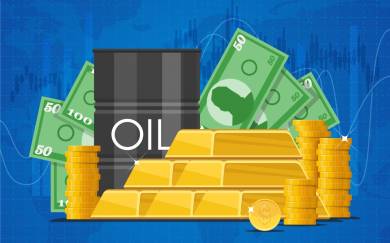China Rolled Out A Special Loan Program! Fed's News

Saxo Strategy Team 22.08.2022 12:33
Summary: Equities closed last week on the defensive as a rising US dollar and especially US treasuries weighed. The US 10-year yield is threatening the 3.00% level for the first time in a month ahead of the important US July PCE inflation data and Fed Chair Powell’s speech on Friday. How forcefully will Powell push back against the virtual melt-up in financial conditions after the market felt the Fed pivoted to less tightening at the July meeting?
What is our trading focus?
Nasdaq 100 (USNAS100.I) and S&P 500 (US500.I)
S&P 500 futures are still rolling over as the US 10-year yield zoomed to 3% on Friday with the index futures trading just above the 4,200 level this morning. The next levels on the downside sit around the 4,100 to 4,170 range, but in the longer term the 4,000 level is the big level to watch. Energy markets are still sending inflationary signals which is key to watch for sentiment this week. In terms of earnings, Palo Alto Networks and Zoom Video will report earnings.
Hong Kong’s Hang Seng (HSI.I) and China’s CSI300 (000300.I)
Hang Seng Index and CSI300 were moderately higher, +0.2% and +0.8% respectively. Chinese developers gained on today’s larger-than-expected cut in the 5-year loan prime rate and last Friday’s report that the PBoC, jointly with the Housing Ministry and the Ministry of Finance to roll out a program to make special loans through policy banks to support the delivery of stalled residential housing projects. Great Wall Motor (02333:xhkg) soared 11%. In A-shares, auto names were among stocks that outperformed. Xiaomi (01810:xhkg) dropped 3% after reporting Q2 revenues -20% YoY and net profit -67% YoY, largely in line with expectations.
US dollar dominates focus in forex this week
The US dollar rally picked up speed last week, with key levels falling in a number of USD pairs last week that now serve as resistance, including 1.0100 in EURUSD and 1.2000 in GBPUSD, both of which now serve as resistance/USD support. A significant break of EURUSD parity will likely add further psychological impact, and more practically, an upside break in yields at the longer end of the US yield curve is playing a supportive roll, one that will intensify its driving roll if the benchmark 10-year US Treasury yield follows through higher above the 3.00% level it touched in trading overnight. A complete sweep of USD strength also threatens on any significant follow through higher in USDCNH as it threatens an upside break here (more below). The next key event risk for the US dollar arrives with this Friday’s Jackson Hole symposium speech from Fed Chair Powell (preview below).
USDCNH
Broad USD strength is helping to drive a move to new cycle highs above 6.84 as the week gets underway, but CNH is not weak in other pairings with G10 currencies, quite the contrary. Still, a move in this critical exchange rate will remain a focus, and the contrast between an easing PBOC (moving once again overnight) and tightening central banks nearly everywhere else is stark. The USDCNH moving higher will receive considerable additional focus if the 7.00 level.
Crude oil prices (CLU2 & LCOV2)
Crude oil turned lower in the Asian overnight after modest gains last week as the focus continues to alter between demand destruction fears and persistent supply shortages. Fears of an economic slowdown reducing demand remains invisible in the physical market but it has nevertheless seen crude oil give up all the post Russia invasion gains while speculators or hedge funds have cut bullish bets on WTI and Brent to the lowest since April 2020. WTI futures trades back below $90/barrel while Brent futures dipped below $96. Still, the gas-to-fuel switch led by record gas prices in Europe has seen refinery margins strengthen again lately and it now adds to the fundamental price-supportive factors. Focus may turn back to Iranian supply early in the week though, with reports that a deal is ‘imminent’.
Cryptocurrencies
The crypto market took a major hit on Friday with the total crypto market cap diving by more than 9 %, but prices have stabilized over the weekend. The total market cap is now close to the psychological $1 trillion level.
US Treasuries (TLT, IEF)
Rising US Treasury yields are pushing back against the strong improvement in financial conditions of recent weeks after the US 10-year Treasury yield benchmark jumped to new highs on Friday, well clear of the prior range after a few teases higher earlier in the week and bumping up against the psychologically key 3.00% level. Any follow through higher toward the 3.50% area highs of the cycle would likely add further pressure to financial conditions and risk sentiment more broadly.
What is going on?
German PPI shocks on the upside
Germany’s July PPI smashed expectations to come in at 5.3% MoM, the biggest single gain since the Federal Republic started compiling its data in 1949 and above the consensus estimate of 0.7%. The data suggests potentially a lot more room on the upside to Eurozone inflation, and a lot more pain for German industries. European PMIs due this week will gather attention, as will Germany’s IFO numbers.
Berkshire Hathaway wins approval to acquire Occidental Petroleum
Warren Buffett’s industrial conglomerate that recently increased its stake in Occidental Petroleum to over 20% following the US Climate & Tax bill which adds more runway for oil and gas companies has now won regulatory approval for acquiring more than 50% the oil and gas company. This means that Berkshire Hathaway is warming up to its biggest acquisition since its Burlington acquisition.
The power shortage in China
China is currently being hit by a heatwave with a large part of the country experiencing -degree Celsius temperatures since the beginning of August. The surge in air conditioning caused electricity consumption to soar. To make things worse, drought has reduced hydropower output. Some provinces and municipalities, especially Sichuan, are curbing electricity supply to industrial users in order to ensure electricity supply for residential use. This has caused disruptions to manufacturing production and added to the headwinds faced by the Chinese economy.
China cut its 5-year loan prime rate loan prime more than expected
China’s National Interbank Fund Center, based on quotes from banks and under the supervision of the PBoC, fixed the 1-year loan prime rate (“LPR”) 5 bps lower at 3.60% and the 5-year loan prime rates (“LPR”) 15 basis points lower at 4.30%. The larger-than-expected reduction in the 5-year LPR, which is the benchmark against which mortgage loan rates in China are set at a spread, may signal stronger support from the PBoC to the housing market.
The Chinese authorities are coming to the developers’ aid in delivering pre-sold homes
Last Friday the Housing Ministry, the Ministry of Finance, and the PBoC, according to Xinhua News, jointly rolled out a program to make special loans through policy banks to support the delivery of presold residential housing projects which are facing difficulties in completion due to lack of funding. Investors will monitor closely this week to gauge if there is additional information about the size of the program and if the PBoC will print money to fund it.
The resurgence of Covid cases in China
Daily locally transmitted new cases of Covid-19 in China persistently stated above 2,000 since August 12, 2022, with Hainan, Tibet, and Xinjiang being the regions most impacted.
The constituent companies of the Hang Seng Index will increase to 73 from 69
Hang Seng Indexes Company announced last Friday to add China Shenhua Energy (01088:xhkg), Chow Tai Fook Jewellery (01929:xhkg), Hansoh Pharmaceutical (03693:xhkg), and Baidu (09888:xhkg) to the Hang Seng Index, bringing the latter’s number of constituent companies to 73 from 69. The changes will take effect on September 5, 2022. In addition, SenseTime (00020:xhkg) will replace China Pacific Insurance (02601:xhkg) as a constituent company of the Hang Seng China Enterprises Index.
Australian share market at a pivotal point
After rising for five straight weeks including last week's 1.2% lift, many market participants hold their breath this rally will continue. However, standing in the way are profit results from a quarter of the ASX200 companies to be released this week. For the final week of profit results, we hear from Qantas (Australia's largest airline), Whitehaven Coal (Australia's largest coal company), as well as other stocks that are typically held in Australian superannuation funds; including Coles, Woolworths, Wesfarmers, Endeavour. And lastly about 20 companies trade ex-dividend this week, however they are not expected to move the market's needle.
Money managers increased their commodity exposure for a third week to August 16
The Commitment of Traders (COT) Report covering positions and changes made by money managers in commodities to the week ending August 16 showed a third week of net buying with funds adding 123k lots to 988k lots, a seven-week high. The buying was broad led by natural gas, sugar, cattle and grains with most of the selling concentrated in crude oil and gold. More in our weekly update out later. Prior to the latest recovery in price and positions hedge funds had been net sellers for months after holding 2.6 million lots at the start of the year.
What are we watching next?
USD and US Treasury yields as Jackson Hole Fed conference is the macro event risk of the week Friday
The US dollar strengthened sharply, with EURUSD challenging near parity, USDCNH breaking higher today after another PBOC rate cut, and USDJPY not far from cycle highs. US Treasury yields have supported the move with the entire curve lifting over the last couple of weeks and longer yields pulling to new local highs last week. The Fed has pushed back consistently against the market’s pricing of a Fed turnaround to easing rates next year with partial success, as expectations for rate cuts have shifted farther out the curve and from higher levels. This week, the key test for markets is up on Friday as the US reports the Fed’s preferred measure of inflation, the July PCE inflation data, while Fed Chair Powell will also speak on Friday, offering the most important guidance on how the Fed feels about how it feels the market understands its intentions.
Earnings to watch
Plenty of important earnings releases this week with the largest ones listed below. Today’s key focus is Palo Alto Networks, Zoom Video, and XPeng. Cyber security stocks have done reasonably well over the past year despite valuations coming down as demand is still red hot, Analysts expect Palo Alto Networks to report revenue growth of 27% y/y. Zoom Video, which was the pandemic superstar, is also reporting today with estimates looking for 9% revenue growth, down considerably from 54% y/y growth just a year ago.
Monday: Palo Alto Networks, Zoom Video, XPeng
Tuesday: CATL, Intuit, Medtronic, JD.com
Wednesday: LONGi Green Energy, Royal Bank of Canada, PetroChina, Ping An Insurance Group, Nongfu Spring, Mowi, Nvidia, Salesforce, Pinduoduo, Snowflake, Autodesk
Thursday: South32, Toronto-Dominion Bank, Fortum, Delivery Hero, AIA Group, China Life Insurance, CNOOC, CRH, Dollar General, Vmware, Marvell Technology, Workday, Dollar Tree, Dell Technologies, NIO
Friday: Meituan, China Shenhua Energy, China Petroleum & Chemical
Economic calendar highlights for today (times GMT)
0800 – Switzerland SNB weekly sight deposits
1230 – US Jul. Chicago Fed National Activity Index
2300 – Australia Aug. Flash Manufacturing/Services PMI
0030 – Japan Aug. Flash Manufacturing/Services PMI
Follow SaxoStrats on the daily Saxo Markets Call on your favorite podcast app:
Apple
Spotify
PodBean
Sticher
Source: Financial Markets Today: Quick Take – August 22, 2022













